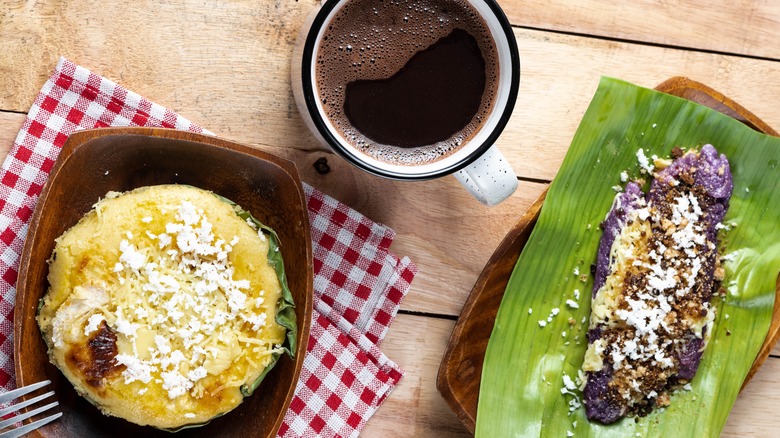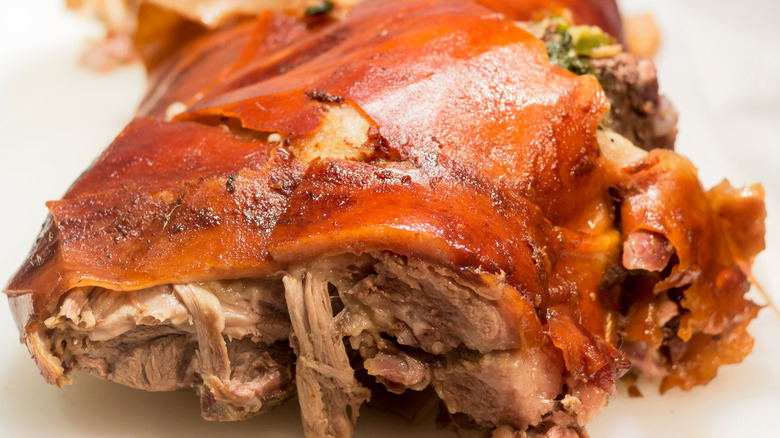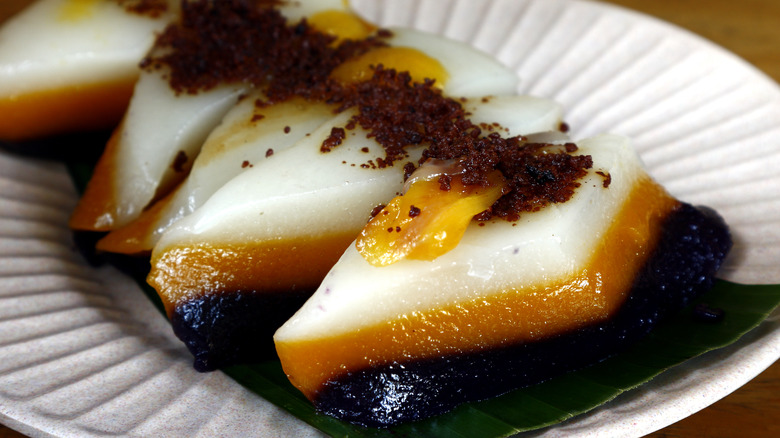Here's What Christmas Dinner Looks Like In The Philippines
In the United States, there is some debate about when to put up the Christmas tree. Some start spreading the Christmas cheer following Halloween while others exercise restraint until the day after Thanksgiving. However, for many in the Philippines, the Christmas festivities can start in September.
In the Philippines, around 92% of the population practices some form of Christianity, with the overwhelming majority being Roman Catholic. The centuries-long Spanish colonization cemented the religious aspect of Christmas, and the American military occupation brought along all things Santa Claus. Decorations are known to be extraordinary and bright with giant, decked-out, artificial Christmas trees, big star-shaped lanterns called parol, abundant twinkling lights, and Christmas tunes from Jose Mari Chan — the Filipino answer to Michael Bublé — blasting for months.
So what is Filipino Christmas food? Well, the traditional dishes are enjoyed for more than a week before the actual holiday. Beginning on December 16, Catholics attend early morning mass each day for Simbang Gabi. Street vendors pack the areas around churches to feed attendees after pre-dawn prayers.
Dishes like purple yam sticky rice dressed with margarine, sugar, and coconut, called puto bumbong, and rice cakes, called bibingka, flavored with salted egg or brown sugar are commonly sold. Hot chocolate made with water is sipped on throughout the Christmas season. The main event happens on Christmas Eve, also called Noche Buena. This late-night meal is typically enjoyed among close family after midnight mass and fuels a celebration that goes well into Christmas morning.
What do Filipinos eat on Noche Buena?
Pork products take center stage including pineapple-glazed ham and whole-roasted pig called lechon, served alongside sweet liver and spicy vinegar sauces. Pinoy spaghetti is another must-have main dish, which includes spaghetti noodles topped with a sweet banana-ketchup sauce loaded with ground meat, hot dogs, and ham. A whole deboned chicken stuffed with ground pork and boiled eggs called galantina or relleno is another impressive dish. Queso de bola — large balls of red-wax-wrapped Edam cheese — also adorn the Noche Buena table. The cheese and slices of ham are often served in sweet and salty egg bread rolls called pan de sal.
White rice is a classic side dish, but some Noche Buena tables dress up this humble starch as Spanish-inspired paella or as arroz ala Valenciana — a mix of glutinous and jasmine rice cooked in coconut milk with assorted meats, vegetables, and raisins. Bringhe is another popular rice dish that is similar to arroz ala Valenciana, but only uses glutinous rice. Mayonnaise-loaded macaroni salad, fried spring rolls called Filipino lumpia Shanghai, pancit Canton noodles, and skewered barbecued meats can also be featured as side dishes.
Rice-based sweets like sapin-sapin — a glutinous rice flour cake with multi-colored layers flavored with jackfruit, coconut, and purple yam — and glutinous sticky rice cakes steamed in banana leaves called suman are common dessert features. Other typical desserts include fruit cake and fruit salad — which often includes canned fruit cocktail, young coconut called buko, sweetened condensed milk, and cream.
How did all these different foods and techniques end up in the Philippines?
The dishes of Noche Buena are a reflection of both reality and aspirational wealth. While there is controversy as to how the government of the Philippines collects data on poverty, around half of the population self-identifies as poor (per The Diplomat). That means those extravagant Christmas spreads are out of reach for many. Because Christmas came to the Philippines from Spanish colonization, the foods reflect that. Tables of the wealthy may be loaded with expensive imported products like ham, Spanish pastries, chocolate, European fruits, and the quintessential queso de bola, but those of more modest incomes are filled out by lots of rice — savory seasoned rice dishes, steamed rice cakes, or Filipino chicken and rice congee called pospas.
The American influence is present in the processed meats of Pinoy spaghetti, macaroni salad, and canned fruit desserts. No matter what the Noche Buena table holds, Filipinos have used food to masterfully blend traditions and reflect their history.
Vinegar, salt-preserved proteins, and rice are foundational to pre-colonial Filipino food. Chinese products made their way to the Philippines through trade and became integral to Filipino dishes like adobo — where a protein is braised in vinegar and soy. Spanish colonization brought ingredients like tomatoes, olive oil, paprika, cheese, and ham, most of which is present on Christmas tables of the middle and upper classes. Later on, the United States military occupation brought canned milk products and meats, sandwiches, and salads.



